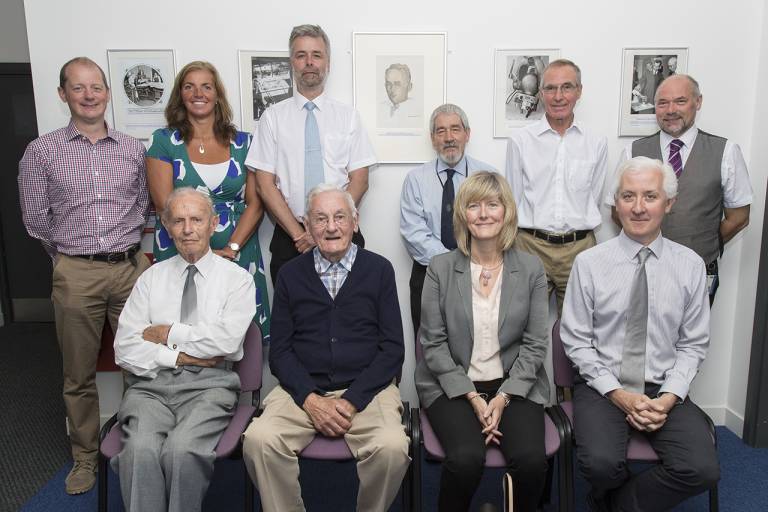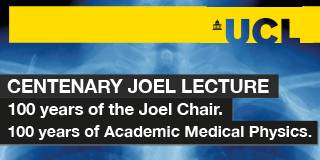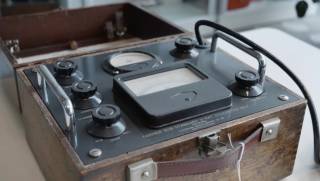The Department of Medical Physics & Biomedical Engineering has a long history at the centre of the early field of Medical Physics.
Department History
The department has a distinguished history with its origins in the Middlesex Hospital, which later merged with UCL. The Middlesex Hospital, which was located a short distance from UCL, operated its first x-ray device in 1896, just months after German physicist Wilhelm Roentgen had discovered x-rays in 1895.
In 1913, Sidney Russ was appointed as the world's first hospital physicist at the Middlesex Hospital. Six years later, Russ joined the Middlesex Hospital Medical School, and in 1920 became the Joel Professor of Physics Applied to Medicine. This was the first Chair of Medical Physics in the world.
Prof. Russ retired in 1946, after pioneering a new scientific approach to radiation protection. Our Department now award an annual prize for our most outstanding undergraduate student in honour of Professor Russ. Prof Russ was succeeded as Joel Chair and head of the department of Physics applied to Medicine at the Middlesex Medical School by Professor Eric Roberts (1946-1971), who founded the academic journal Physics in Medicine and Biology. He was followed as head of department and Joel Professor by Prof. James Tait (1971-1982), who is believed to be the first medical physicist to be appointed a Fellow of the Royal Society.
Meanwhile, a new Department of Medical Physics at University College Hospital (UCLH) Medical School had been formed in 1943. Its first Head of Department was Sidney Osborn (1943-1962) who in November 2003 returned to the department to give a fascinating lecture on "Sixty years in medical physics". This lecture was recorded and can be viewed online in our Joel Lecture playlist on YouTube. Sidney Osborn left to become Director of Medical Physics at Kings College Hospital in 1962 and was succeeded as head of department by John Clifton. The UCLH Medical School became part of UCL in 1981.
In 1987, the Middlesex Hospital Medical School merged with the UCL Medical School. As a result, the Radiation Physics and Image Processing groups at the Middlesex Hospital Medical Physics department joined the UCL Medical Physics department, led by John Clifton (who became the fourth Joel Professor in 1990).

John Russ – son of Sir Sidney Russ, one of the world's first medical physicists – visited the Department with his family in 2016.
From top left: Adam Gibson, Clare Elwell, Peter Marsden, David Delpy, Rob Speller, Paul Ganney
From bottom left: John Clifton, John Russ, Catherine Russ, Jem Hebden
Prof. Clifton retired in 1992, and a decision was taken to split the department into two, forming a "joint" medical physics department. One half became an academic department within the university, while the other became a department within the UCLH NHS Trust. The heads of these two departments were Professor Prof David Delpy (UCL Department of Medical Physics & Bioengineering) and Professor Roland Blackwell (UCLH NHS Trust Department of Medical Physics & Bioengineering). However, most staff within the two departments remained located together within the same building: Shropshire House in Capper Street. In 1993 Prof Roger Ordidge was appointed the fifth Joel Professor. Having been appointed a Fellow of the Royal Society, Prof. Delpy stood down as Head of Department in 1999 to become the UCL Vice Provost for Research, and later Chief Executive of EPSRC in 2007. He was succeeded as Head of Department by Prof Andrew Todd-Pokropek (1999-2008).
In 2004, both departments moved out of Shropshire House. The academic department moved to its current location, a new building in the centre of the UCL campus, known as the Malet Place Engineering Building. The NHS Trust department moved several times, and is currently located in the basement of the main UCLH hospital building on Euston Road. Geoff Cusick became the head of the NHS Trust department following the retirement of Prof. Blackwell in 2004, while Prof Jem Hebden became Head of the UCL Department when Prof. Todd-Pokropek stepped down in 2008. Prof. Peter Marsden succeeded Geoff Cusick as head of the NHS Trust department in 2010. In 2011, Prof Ordidge left UCL and Prof Robert Speller was appointed the sixth Joel Professor of Physics Applied to Medicine.
In 2014 the department launched a new undergraduate programme in biomedical engineering, offering BEng and MEng degrees to compliment existing BSc and MSci degrees in medical physics. So that its name would be aligned with these programmes, the department was renamed the Department of Medical Physics & Biomedical Engineering.
In 2019, Prof. Jem Hebden stepped down as Head of Department in order to return to his research and teaching full time. Prof. Hebden was succeeded by Prof. Andy Nisbet, our current Head of Department.
- Key dates in the department's history
1895 – German physicist Wilhelm Roentgen discovers X Rays
1896 – First x-Ray device operated at the Middlesex Hospital
1913 – Sidney Russ appointed world’s first hospital physicist Middlesex Hospital
1920 – Russ becomes Joel Professor of Physics Applied to Medicine (the first Chair of Medical Physics in the world).
1943 – New Department of Medical Physics opens at University College Hospital (UCH), led by Sidney Osborn.
1946 – Russ retires and is succeeded by Professor Eric Roberts
1962 – Sidney Osborn succeeded as Head of UCH Department by John Clifton
1971 – Professor James Tait takes over from Professor Eric Roberts
1981 – UCH Medical School becomes part of UCL
1987 – Middlesex Hospital Medical School merges with UCL Medical School. Radiation Physics and Image Processing groups at the Middlesex Hospital become part of the UCL Medical Physics Department, led by John Clifton.
1990 – John Clifton becomes fourth Joel Professor
1992 – John Clifton retires
1992 – A joint medical physics department is formed comprising the UCL Department of Medical Physics and Bioengineering led by Professor David Delpy, and the UCLH NHS Trust Department of Medical Physics and Bioengineering led by Professor Roland Blackwell
1993 – Professor Roger Ordidge appointed the fifth Joel Professor
1999 – Professor David Delpy stands down as Head of Department to become the UCL Vice Provost for Research, and later Chief Executive of EPSRC (2007)
1991 – Professor Andrew Todd-Pokropek becomes Head of Department
2004 – Academic department moves to Malet Place Engineering Building
2004 – Professor Roland Blackwell retires, and is succeeded as head of the NHS Trust Department by Geoff Cusick
2008 – Professor Todd-Pokropek steps down and is succeeded as head of the UCL department by Professor Jem Hebden
2010 – Geoff Cusick retires, and is succeeded by Professor Peter Marsden as head of the NHS Trust department in 2010
2011 – Professor Robert Speller appointed the sixth Joel Professor of Physics Applied to Medicine.
2014 – Biomedical Engineering undergraduate programme launches, offering BEng and MEng degrees to complement existing BSc and MSci degrees in Medical Physics.
2014 – Department renamed the Department of Medical Physics & Biomedical Engineering
2019 – Professor Jem Hebden steps down and Professor Andy Nisbet becomes Head of Department
2020 – Department celebrates 100 year anniversary of the Joel Chair with a special centenary Joel Lecture
 Close
Close



